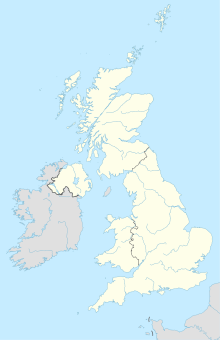Kidderminster
Coordinates: 52 ° 23 ′ N , 2 ° 15 ′ W
Kidderminster is a town in the district of Wyre Forest the British county of Worcestershire . Located about 25 km southwest of Birmingham and traversed by the Stour River, it is particularly known as a location for carpet manufacturing. In 2001 the population was 55,348. Kidderminster's twin town is Husum in Schleswig-Holstein , Germany .
history
Today's Kidderminster emerged from individual settlements in the eighth century and initially bore the name Chideminstre , which was also mentioned in the Domesday Book of 1086. Over the centuries, the name "Chideminstre" was changed to "Chiderminster" to the current spelling, which has been used since the 17th century.
In the 15th century the church "St Mary & All Saints", which still exists today, was built. Richard Baxter , a British theologian and founder of a milder version of Calvinism , was there - with interruptions - as a clergyman from 1641 to 1661.
Also in the late Middle Ages, the place, which had already been granted market rights in 1225 , began to develop into a regional center for textile production. This formed the cornerstone for the carpet industry in Kidderminster that emerged in the 18th century. The first carpet factory was opened there in 1735, which was followed by numerous other production facilities and suppliers in the following years. The company "Brintons", which was founded in 1783 and is still based in Kidderminster today, developed into the town's largest manufacturer. The carpet industry caused massive population growth in the city, but offered its employees poor living and working conditions. Even child labor was well into the 19th century common. As a reaction to the unsatisfactory conditions, there were several extensive strikes by textile workers in Kidderminster, including a five-month stoppage in 1828. From the middle of the 20th century, the importance of the carpet industry in Kidderminster declined significantly. To date, however, there are several hundred jobs there.
In 1772 the Staffordshire-and-Worcestershire Canal was opened between Stourport-on-Severn , Kidderminster and Great Haywood ( Staffordshire ) on the Trent-and-Mersey Canal under the leadership of the engineer James Brindley . During the industrial revolution, these so-called narrowboat canals were the only economic transport route for large and bulk goods and the basis for the city's economic development. The railway did not reach Kidderminster until 1852 when the "Oxford, Worcester and Wolverhampton Railway" opened a branch line from Worcester via Kidderminster to Stourbridge (- Birmingham). From 1878 to 1963 there was also a railway line from Kidderminster to Shrewsbury .
traffic
Kidderminster is on the railway line from Birmingham via Stourbridge to Worcester. This connection is operated by the Central Trains company for passenger transport . In peak times the trains are also Chiltern Railways from London coming over Birmingham also offered to Kidderminster. A section of the former railway line to Shrewsbury is now served from Kidderminster by the museum railway Severn Valley Railway .
The town can be reached by road via the A442, A448, A449 and A456 as well as the M5 Motorway, which is about 15 km to the east .
Others
- St Mary and All Saints' Church in Kidderminster is a Grade I listed building.
- Kidderminster is the seat of the Independent Kidderminster Hospital and Health Concern party . Since 2001, with its chairman Richard Taylor, it has been one of the few members of the British House of Commons who is not one of the three major British parties .
- Since 1976 there has been a town partnership between Kidderminster and Husum .
- The Kidderminster Harriers football club is based here and currently plays in the Conference League .
Personalities
- Richard Baxter (1615–1691), Puritan pastor and writer of edification
- Rowland Hill (1795–1879), reformer of the English postal system
- Thomas Helmore (1811–1890), choirmaster, author and composer
- Sir Walter Nash (1882–1968), Prime Minister of New Zealand from 1957 to 1960
- AW Watkins (1895-1970), sound engineer and sound engineer
- John Wyer (1909–1989), motorsport engineer and race director
- Robert Hamer (1911–1963), director and screenwriter
- David Morris (1930–2007), Labor Party politician and peace activist
- Peter Collins (1931–1958), racing car driver
- John Burton (* 1941), racing car driver
- John Forgeham (1941-2017), actor
- Paul Frampton (* 1943), physicist
- Robert Plant (* 1948), rock singer, grew up in Kidderminster
- Alun Evans (born 1949), football player
- Sammi Davis (* 1964), actress and photographer
- Charles Linden (* 1968), life coach and book author
- Ewan Pearson (* 1972), DJ and musician in the field of electronic dance music
- Graham Gardner (* 1975), writer
literature
- Nigel Gilbert: A History of Kidderminster , Phillimore & Co 2004, ISBN 1860773095
